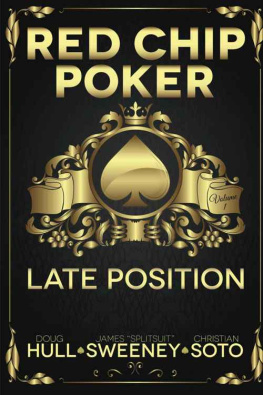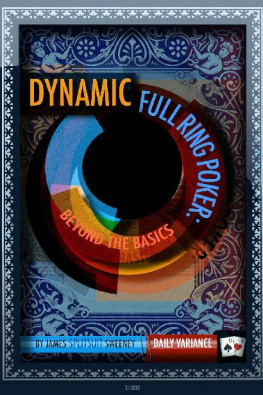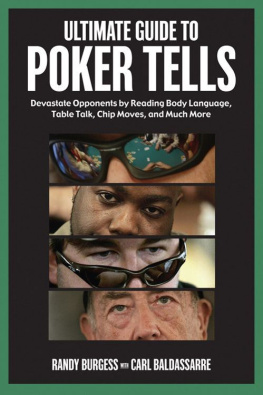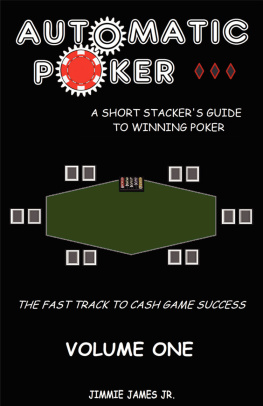James Sweeney - Red Chip Poker: Late Position
Here you can read online James Sweeney - Red Chip Poker: Late Position full text of the book (entire story) in english for free. Download pdf and epub, get meaning, cover and reviews about this ebook. year: 2014, genre: Home and family. Description of the work, (preface) as well as reviews are available. Best literature library LitArk.com created for fans of good reading and offers a wide selection of genres:
Romance novel
Science fiction
Adventure
Detective
Science
History
Home and family
Prose
Art
Politics
Computer
Non-fiction
Religion
Business
Children
Humor
Choose a favorite category and find really read worthwhile books. Enjoy immersion in the world of imagination, feel the emotions of the characters or learn something new for yourself, make an fascinating discovery.
- Book:Red Chip Poker: Late Position
- Author:
- Genre:
- Year:2014
- Rating:5 / 5
- Favourites:Add to favourites
- Your mark:
- 100
- 1
- 2
- 3
- 4
- 5
Red Chip Poker: Late Position: summary, description and annotation
We offer to read an annotation, description, summary or preface (depends on what the author of the book "Red Chip Poker: Late Position" wrote himself). If you haven't found the necessary information about the book — write in the comments, we will try to find it.
Red Chip Poker: Late Position — read online for free the complete book (whole text) full work
Below is the text of the book, divided by pages. System saving the place of the last page read, allows you to conveniently read the book "Red Chip Poker: Late Position" online for free, without having to search again every time where you left off. Put a bookmark, and you can go to the page where you finished reading at any time.
Font size:
Interval:
Bookmark:
Written by
Doug Hull,
James Sweeney,
Christian Soto
Copyright 2014 by Doug Hull & James SweeneyAll rights reserved. This book or any portion thereofmay not be reproduced or used in any manner whatsoeverwithout the express written permission of the publisherexcept for the use of brief quotations in a book review.
First Printing, 2014 www.RedChipPoker.com All rights reserved.ISBN-13: 9781495421273
All rights reserved.ISBN-13: 9781495421273 iii
iii
 v
v
Doug Hull
Thank you to Bill, Martin and the rest of the WPDG regulars in Las Vegasthat created a great study group and gave a venue for James and I to meet andeventually form this partnership. Thanks to Laura for all the tireless editing.She is the best poker player that has never played a hand of poker.

James SplitSuit Sweeney
I would first and foremost like to thank my fianc Denae and son Prestyn.Without their unwavering support I would have never finished this book. I loveyou both!
I would also like to thank my parents, sister, and friends for their lifetimeof support. A special thanks to my collaborative authors Doug Hull andChristian Soto for creating a great atmosphere to write and share ourknowledge. And a final thank you to Chris Cwar Warren, TDK, Greg Walker, every student, every customer, and every single person who has given meconstructive criticism throughout the years. Cheers!

Christian Soto
First and foremost, I would like to thank my family for an astoundingamount of patience throughout the writing of this book and all their continuedsupport throughout my life.
My best friends, Sean Meyer and Paul Alarcon, for their words ofencouragement from day one on this journey.
For entire the East Coast poker community, thank you, for providing agreat atmosphere to play, learn, and grow as a poker player.
Enjoy the read.
This book is laid out differently than other poker books. A tabular formatis used so that all the relevant stack sizes, positions, holdings and table imagesare easily seen during every street.

In this format, the action of each player is in the action column. If a playermakes multiple actions per street, they are separated by slashes. This handwould be written out as follows:
A Loose Aggressive player limps Under the Gun. It is folded to a badregular in the cutoff who also limps. Hero raises on the Button and only theLAG calls.
This format is continued on each street in a different table. The startingstacks for each street are updated to make the action clearer.
We can see that on the turn the LAG bet and then folded to our raise.The other thing you will notice is that each chapter starts with a tableshowing the Villains flaw, the difficulty rating of the play we made, and theexploit that we used. The icons are there to make it very fast to flip through thebook for the situations you are looking for later.
This book is has two types of content. The first and lengthier type looks atdifferent hands that illustrate a pattern in your opponents strategy. Thesepatterns are identified and then exploited. The second type of content is a setof missions for you to accomplish at the poker table. Each of these missions isdesigned to give you concrete actions you can take to either eliminate aweakness in your own game or to exploit a weakness in your opponents.
Most opponents at the poker table have a fairly static way that they thinkabout poker. I like to classify players roughly as those that make calling errors(too loose), versus folding errors (too tight), versus betting errors (tooaggressive), versus checking errors (too passive).
This makes them fall into predictable errors. When someone is predictable,they are exploitable. This book is all about identifying typical patterns and howto exploit them. For example, players are often announcing how they feel abouttheir hands with bet sizing tells. This book shows you what to do when theyfail at information hiding in this way.
When you have embraced the lessons of this book, you will find it mucheasier to fire in big bluffs. You will no longer be thinking about your own weakhand but instead will be thinking about the Villains weak range. You can fearlessly fire when your focus is on the opponents cards rather than your own.
The hand reviews allow you to hear my inner dialog as a hand unfolds. Theauthors are all aggressive players, but it is not wild flinging of chips. It is a cold,calculated brand of aggression that is designed to get better hands to fold andworse hands to call. This book will teach you to deviate from the typicalstrategies that most people use. You will then be able to adopt this much moreexploitive and aggressive style. It will take a lot of work to get from here tothere, but it will be worth it. The missions in the later part of the book will giveyou the roadmap to get there. They are not there to be simply read. They arethere as milestones for you to reach for on your path to better poker.
ixThis should not be your first poker book and probably not your second orthirdeither.Thereisanexpectation that the readerhasabaselineunderstanding of the game. We use some tools in this book to help with themath away from the table. Using these tools after a session will help tuneyour intuition for when you are playing in real-time. Here are somerecommended concepts and tools that will help in understanding this bookand poker in general.
All links below are on RedChipPoker.com. http://redchippoker.com/important-poker-tools-concepts/Combos
Combos, Combinations, Combinatorics...they all mean the same thing.They mean we are looking at hands from a mathematical point of view and counting the ways our opponent can make certain hands. If you are totallynew to the concept you should start with this short and sweet video from ThePokerBank.com :
 Starting from preflop, we know that a player can have:Six combos of any pocket pair
Starting from preflop, we know that a player can have:Six combos of any pocket pair
Font size:
Interval:
Bookmark:
Similar books «Red Chip Poker: Late Position»
Look at similar books to Red Chip Poker: Late Position. We have selected literature similar in name and meaning in the hope of providing readers with more options to find new, interesting, not yet read works.
Discussion, reviews of the book Red Chip Poker: Late Position and just readers' own opinions. Leave your comments, write what you think about the work, its meaning or the main characters. Specify what exactly you liked and what you didn't like, and why you think so.







